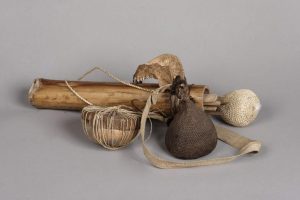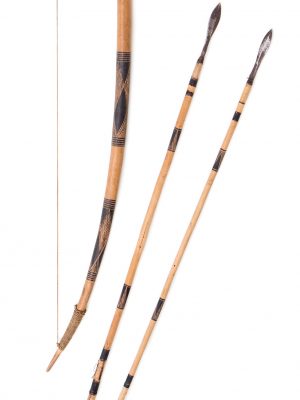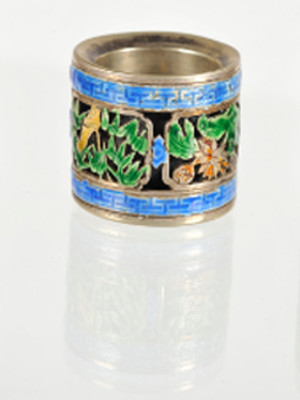Matis quiver and blowpipe accessories
Javari valley, Mato Grosso, Brazil
20th century
Bamboo, reed, rope, cotton, palm tree leaf, bone
Gift of Museum’s Friend Association, 2013
Inv.2013.8.1
______________
This original ensemble was made by one or several members of the Matis people who live in the Vale do Javari in Brazil. It has all the useful accessories for blowpipe hunting. The quiver, made from a bamboo tube, contains tips that are dipped in curare. A piece of cloth allows it to be worn as a sling bag. Directly attached to the body of the quiver, an agouti jaw (large rodent) helps sharpen the tips so that they stay harmful. Natural ligatures hold the two pouches in vegetal fibers that carry the cotton fillers used to protect the mouth from the backlash of the dart when shot. A small wooden bowl, carefully covered in leaves, is also suspended to the quiver by a small rope. It contains the curare, which the hunter uses to cover his darts with. The latter only dips the tips in order to avoid direct contact with the poison. This system allows carrying the product without any risks while having it within reach.
The blowpipe is mostly used for monkey hunting, whether spider monkeys (black monkey), woolly monkeys, dark titi monkeys or saki monkeys.
Blowpipe darts are also used by shamans whose power travels through a substance called “sho”. This ingredient has positive and negative aspects and can be used for example during rituals to hurt enemies through these projectiles (to spread diseases for example).
The Matis people
The Matis people are an indigenous people of Amazonia whose first contacts with Westerners occurred in the 1970s. They were 390 then, named “Jaguar people” because of their numerous face ornaments. This “encounter” caused a strong demographic decline, during which more than half the population died because of epidemics brought by Westerners.
Today, although they use imported manufactured products, they stay attached to their traditional beliefs and rituals. If hunting remains the most prestigious activity, agriculture provides most of their sustenance. The actual Matis population is approximately 250 people.















